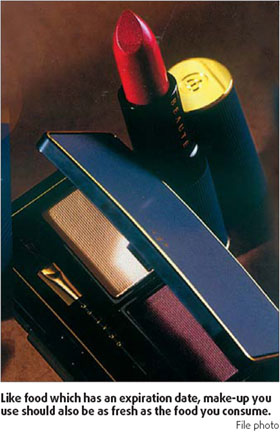The hidden dangers of hiding your flaws
LONDON: Vintage fashion may be fabulous, but old make-up is putting women's health and beauty at risk, according to new research that has found the tradition of collecting antiques extends to cosmetics and toiletries.
Show us a woman's handbag, say experts from the College of Optometrists, and we will show you a 10-year-old lipstick, a five- year-old tube of mascara and a jar of rancid moisturizer, all teeming with harmful bacteria.
"It's ironic that women spend so much time and money on cosmetics to make themselves look beautiful, and yet in using it, they are making themselves vulnerable to infections that are anything but attractive," says Dr Susan Blakeney, optometric adviser to the college.
The survey found that while women are keen to experiment with new cosmetics, they are less keen on throwing out the old. This morning, one in five women in her late 30s or 40s will have put on her make-up using a product over five years old.
"All food has an expiration date and people don't think twice about throwing away milk when that date comes," Blakeney says. "The make-up you use should be as fresh as the food you consume. But women keep their make-up for many years, not to mention sharing it with friends and applying it in ways that could lead to serious damage."
Mascara should be thrown away after three to six months, says Blakeney, because the pumping action of the brush in the dispenser can drive bacteria deep down into the product. Dangers, however, lurk in other products too: foundation gets absorbed in the skin while lipstick enters the mouth when you eat.
"I had a client only last week who has suffered from red, watery eyes for years. It was only by chance that she stopped wearing mascara for a month and realized the problem cleared up. Now she throws away her mascara every three months and her eyes are completely perfect," she says.
British women put great emphasis on making themselves look beautiful, painting their faces to the tune of GBP1 billion a year and spending more on cosmetics than any other nation in Europe.
"Perhaps it is because women are now constantly topping up their make-up bags with new products that they never actually finish any older products," says Blakeney. "These older cosmetics lie around for years, each one a little hothouse for bacteria."
Many of the best-loved girly traditions are put at risk by the college's findings. Getting together to pile on the slap before a night out is fraught with danger, for example: over a third of women under 24 admit to sharing mascara with friends.
"Mascara wands can harbor the bacteria that cause conjunctivitis," says Blakeney. "If a group of friends is using an infected wand, it is almost inevitable that the infection will be spread throughout them all."
But it is those trying to save time in the mornings by putting their make-up on while en route to work who are risking permanent eye damage. "It is easy to scratch a cornea if you are trying to apply mascara on the move, and that leaves you vulnerable to all sorts of nasty infections," says Blakeney. "If, in addition, your mascara wand is bustling with bacteria, contamination is inevitable."
EU legislation requires cosmetics to be labeled with a date of minimum durability but there is no statutory definition of how long a product remains usable. So how can you tell if your make-up is past its best?
"Treat it like food - sniff it," recommends Carol Dukes, co-founder of the www.thinknatural.com website. "Anything that looks, smells or tastes bad, is bad, so trash it." Dukes also recommends keeping lids screwed on tight and keeping products out of sunlight.
The best test, says Sebastian Parsons, managing director of the cosmetics and toiletry company Dr Hauschka, is to use your eyes and nose. "I recently found some cleansing cream - the tube had been opened and I'd forgotten about it," he says. "The first half inch had gone off, but the rest was absolutely fine. It's always worth opening up the container and having a go."
The Guardian
(China Daily 06/15/2007 page18)














